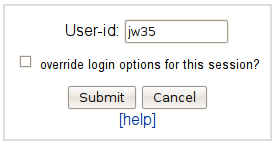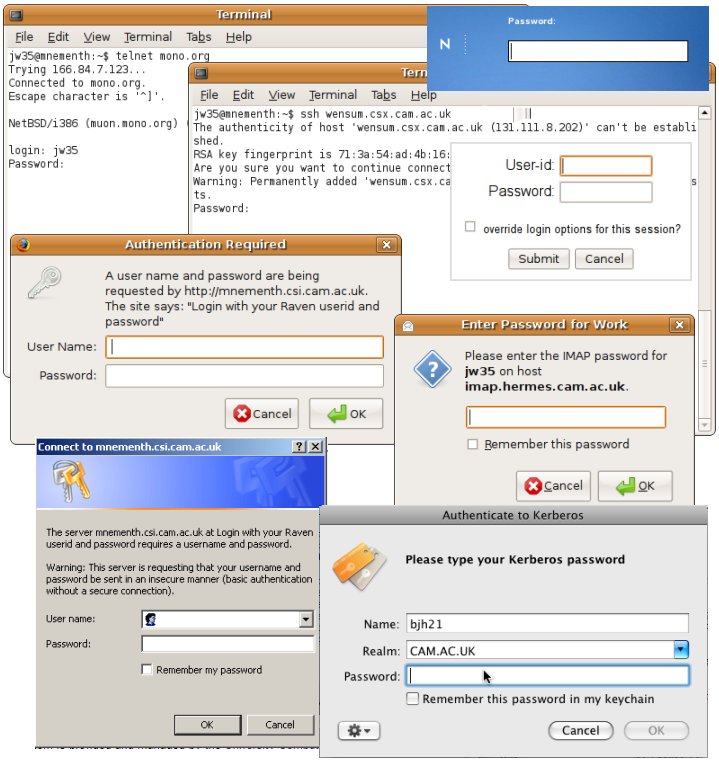Re-using Raven's password database: Difference between revisions
(Further development) |
(Add login box montage, centre images) |
||
| Line 11: | Line 11: | ||
We could just forget passwords and simply ask people to tell us what their CRSid was. This would even simplify Raven itself: | We could just forget passwords and simply ask people to tell us what their CRSid was. This would even simplify Raven itself: | ||
[[Image:Simple-raven-login.png|Raven login, no password]] | [[Image:Simple-raven-login.png|center|Raven login, no password]] | ||
Doing this would save people from having to remember their password, and would save the CS from having to issue them. Both of these would be significant advantages. Anyone can easily set up almost any system 'protected' in this way - the hard part might actually be ''stopping'' it from asking for a password. | Doing this would save people from having to remember their password, and would save the CS from having to issue them. Both of these would be significant advantages. Anyone can easily set up almost any system 'protected' in this way - the hard part might actually be ''stopping'' it from asking for a password. | ||
| Line 51: | Line 51: | ||
There is a further problem, which actually also manifests in the previous two solutions as well. When asked for their 'central authentication system password', how can the user know that it's safe to quote it? Given all of the following, which is the bogus site that is just trying to capture your password? | There is a further problem, which actually also manifests in the previous two solutions as well. When asked for their 'central authentication system password', how can the user know that it's safe to quote it? Given all of the following, which is the bogus site that is just trying to capture your password? | ||
[[Image:Login-box-montage.jpg|center|Assorted login boxes]] | |||
Note that this vulnerability is essentially the one being exploited by the current round of 'phishing' attacks aimed (with significant success) at getting people to disclose the electronic banking and mail system passwords. There is no obvious solution to this. | Note that this vulnerability is essentially the one being exploited by the current round of 'phishing' attacks aimed (with significant success) at getting people to disclose the electronic banking and mail system passwords. There is no obvious solution to this. | ||
Revision as of 13:51, 3 December 2008
WARNING: this is incomplete 'work in progress'
Raven currently provides a reasonable authentication system for interactive, web-based applications but doesn't support non-interactive web-based applications, nor non-web ones, and this covers a multitude of potential uses: Windows/MacOS/Unix logon, IMAP, POP, SMTP, LDAP, WebDAV, etc., etc. Since Raven of necessity has a database containing username/password pairs for most people in the University, and most people know their Raven password, it is tempting to assume that extending it to support these other uses would be simple.
This paper explores various ways in which password-based authentication could be provided and attempts to point out the advantages and drawbacks of each proposal. In reading this, it is useful to consider what security properties you wouild actually want from such a system. It's also important to consider who might be attempting to attach what, and how much we care about it: are we talking about a) a bored University student, b) a tabloid journalist, c) an organised criminal, or d) the American NSA, and are they trying to gain access to a) their mate's photo archive, b) the next heir to the throne's email account, c) the University financial system, or d) everything.
- "At first he thought that the whole world had blown up. Then he thought that only the Forest part of it had; and then he thought that only he had..." Piglet, Winnie-The-Pooh, A.A. Milne, Methuen 1926.
Option the first: forget passwords
We could just forget passwords and simply ask people to tell us what their CRSid was. This would even simplify Raven itself:
Doing this would save people from having to remember their password, and would save the CS from having to issue them. Both of these would be significant advantages. Anyone can easily set up almost any system 'protected' in this way - the hard part might actually be stopping it from asking for a password.
The obvious downside is that we'd have to trust everyone who can get to a login prompt not to lie (and for many networked services this means everyone in the entire world), and this is rather unrealistic.
Option the second: use a single fixed password
Rather than forgetting passwords completely, we could could use a single, fixed, 'well known' password to protect all accounts.
This would be easy to remember (and easy to recover if you forgot it). It's also fairly easy to set up a system protected in this way.
The problem is that we'd still have to trust everyone who knew the password not to lie. It's fair to assume that a 'secret' known by 55,000 (and rising) people would not stay a secret for long so we'd have to trust quite a lot of people not to lie. It would also be next to impossible ever to change this password. Again this is probably not a realistic option (though this doesn't actually stop people using this as an authentication 'solution', though usually on a small scale - think of the PIN used to arm and disarm most intruder alarm systems).
Option the third: distribute a list of user name/plaintext password pairs
We could (in theory, though not currently in practice) extract a list of user names and plain text passwords from Raven, one for each user, and then distribute this list to every system that needs to authenticate users.
Users would quote their user name and password, the system could look up the the user name and compare the offered password with the one on the list - if it matches they get in, if not they don't. Implementing authentication in this way would be fairly easy, and system administrators could post-process the list into whatever form their system actually needed.
This largely avoids the problem of having to trust potential users not to lie - the vast majority of users will only be able to authenticate as themselves. It's still possible for users to give away their password, but that's a feature of password-based authentication that's effectively impossible to avoid.
The list itself, however, is now a major problem. Anyone with access to it can authenticate as any user on any system using this authentication service, so we'd still have to trust people not to do so. Worse, many users use the same password for multiple authentication systems, so any with access to the list may also be able to authenticate on systems that don't use this authentication system.
All of the managers of all the systems using the authentication service would inherently have access to the list. Even if we choose to assume that none of these administrators will be actively malicious, there is still the danger that they might accidentally or recklessly allow it to leak (from a hacked server, on a memory stick, on a laptop left on a train, etc.). So the security of any one system under this model still depends on a whole group of people that the individual system's administrator has no particular reason to trust. In practice it would be necessary to severely restrict which systems could participate in such an authentication system, if it could be made to work at all, to the point where it could never provide a 'universal' authentication system for the University.
Option the fourth: distribute a list of user name/'crypted' password pairs
Rather than distributing plaintext passwords, we could distribute them in a 'non-reversibly encrypted' (or 'hashed') format. For example the 'crypt' or 'md5' password format used in Unix password files. In principle this makes it possible to check that a proffered password is correct (by encrypting it and checking the encrypted versions match), without exposing all the passwords on the list.
Unfortunately, hashed passwords can be recovered by a 'dictionary attack', in which an attacker generates a dictionary of words and their plaintext equivalents and then searches the hashed passwords for matches. Since users have a bad habit of choosing common words (or trivial variations of them) as passwords, such an attack will normally recover a reasonable proportion of passwords. So even with hashed passwords the list would be vulnerable to the problems mentioned in the previous section. Worse, everyone logging-in would still have to offer their plain text password for verification, at which point they would still be vulnerable to a malicious or negligent system administrator.
Option the fifth: central password verification
Even if a list could be made to work, distributing it is going to be difficult. Especially if you need it in a timely manner. One solution to this would be to have a 'central password verification service'. In this model, a system using the authentication service solicits a user name and password for a user and forwards them (hopefully in a secure fashion) to the central service which returns a match/no match response. Almost any network protocol can be used for this, but it's quite common to use LDAP and overload LDAP's 'user login' process to provide authentication. It;s not uncommon for software to suooprt this 'out of the box'. Alternatives include POP, IMAP, RADIUS, and home-grown protocols. Configuring any of these so they don't actually expose plaintext passwords on the network makes them somewhat more complicated, and sometimes is not supported, and so is a step which is often omitted.
This approach avoids exposing the list of everyone's plaintext or hashed passwords to system administrators (and potentially others) which significantly reduces the exposure. However as in the previous example everyone logging-in still has to offer their plain text password for verification, at which point it is still be vulnerable to a malicious or negligent system administrator. Again, this means that such a service with a particular password could only realistically be offered to sets of services whose administrators are realistically able to trust each other and who are willing to accept the risk that one of their number might one day make a mistake.
There is a further problem, which actually also manifests in the previous two solutions as well. When asked for their 'central authentication system password', how can the user know that it's safe to quote it? Given all of the following, which is the bogus site that is just trying to capture your password?
Note that this vulnerability is essentially the one being exploited by the current round of 'phishing' attacks aimed (with significant success) at getting people to disclose the electronic banking and mail system passwords. There is no obvious solution to this.
Option the sixth: Kerberos (or similar)
Kerberos was deliberately designed to overcome this problem. It allows a central verification service to assert that a user has correctly quoted a password, and so has authenticated themselves, without the user having to disclose their password to anything other than their local workstation

